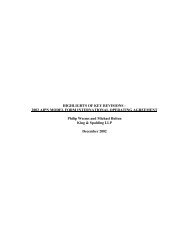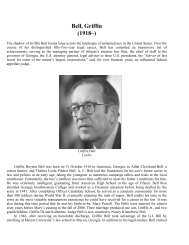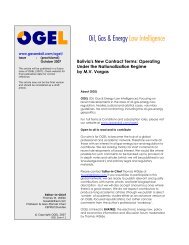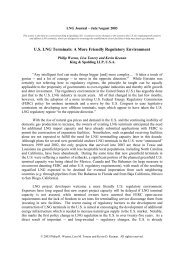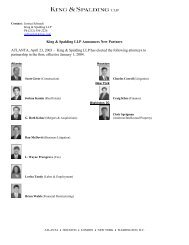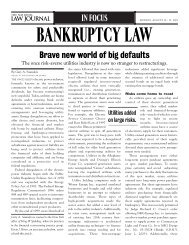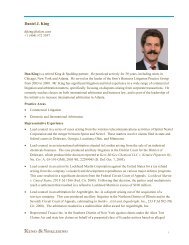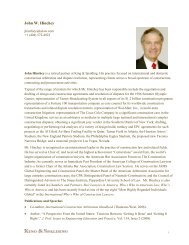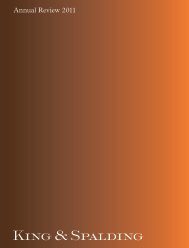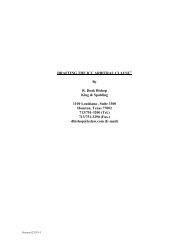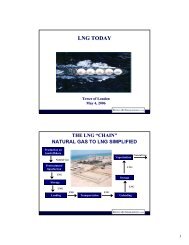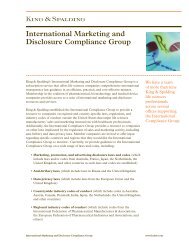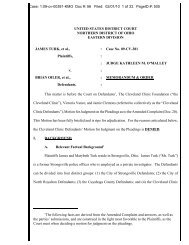Use and Misuse of Expert Opinions at the Class ... - King & Spalding
Use and Misuse of Expert Opinions at the Class ... - King & Spalding
Use and Misuse of Expert Opinions at the Class ... - King & Spalding
You also want an ePaper? Increase the reach of your titles
YUMPU automatically turns print PDFs into web optimized ePapers that Google loves.
<strong>Use</strong> <strong>and</strong> <strong>Misuse</strong> <strong>of</strong> <strong>Expert</strong> <strong>Opinions</strong><br />
<strong>at</strong> <strong>the</strong> <strong>Class</strong> Certific<strong>at</strong>ion Stage<br />
<strong>Use</strong> <strong>of</strong> expert opinions should not be permitted, but if courts continue to do so,<br />
defendants must <strong>at</strong>tack <strong>the</strong> expert’s qualific<strong>at</strong>ions <strong>and</strong> present <strong>the</strong>ir own<br />
By Dwight J. Davis <strong>and</strong><br />
By Karen R. Kowalski<br />
AS THE number <strong>of</strong> class actions in <strong>the</strong><br />
United St<strong>at</strong>es increases, so does <strong>the</strong><br />
device <strong>of</strong> employing expert witnesses to<br />
give opinions <strong>at</strong> <strong>the</strong> class certific<strong>at</strong>ion stage<br />
as to <strong>the</strong> ultim<strong>at</strong>e legal issues <strong>of</strong> manageability,<br />
predominance <strong>and</strong> superiority, <strong>the</strong><br />
elements required in federal court by Rule<br />
23 <strong>of</strong> <strong>the</strong> Federal Rules <strong>of</strong> Civil Procedure.<br />
The use <strong>of</strong> experts <strong>at</strong> this stage <strong>of</strong> class<br />
litig<strong>at</strong>ion is inappropri<strong>at</strong>e. They should be<br />
prohibited from testifying on <strong>the</strong> legal propriety<br />
<strong>of</strong> class certific<strong>at</strong>ion, but <strong>the</strong>re are<br />
ways <strong>of</strong> effectively countering <strong>the</strong>ir opinions<br />
if <strong>the</strong>y are allowed to testify.<br />
IADC member Dwight J. Davis is a<br />
partner in <strong>the</strong> New York <strong>of</strong>fice <strong>of</strong> <strong>King</strong> &<br />
<strong>Spalding</strong> <strong>and</strong> has litig<strong>at</strong>ed many class actions.<br />
He is a gradu<strong>at</strong>e <strong>of</strong> The Citadel<br />
(B.A. 1975) <strong>and</strong> Mercer University (J.D.<br />
1982). An associ<strong>at</strong>e in <strong>the</strong> New York <strong>of</strong>fice,<br />
Karen R. Kowalski is a gradu<strong>at</strong>e <strong>of</strong><br />
Gonzaga University (B.A. 1997) <strong>and</strong> St.<br />
John’s University (J.D. 2001).<br />
The authors thank Kara Ong, an associ<strong>at</strong>e<br />
in <strong>the</strong> Atlanta <strong>of</strong>fice <strong>of</strong> <strong>King</strong> &<br />
<strong>Spalding</strong>, for her assistance in <strong>the</strong> prepar<strong>at</strong>ion<br />
<strong>of</strong> this article.<br />
USING EXPERT TESTIMONY<br />
TO ESTABLISH PROPRIETY<br />
OF THE CLASS<br />
Although case law has established th<strong>at</strong><br />
<strong>the</strong> proponent <strong>of</strong> class certific<strong>at</strong>ion has <strong>the</strong><br />
heavy burden <strong>of</strong> proving <strong>the</strong> elements <strong>of</strong><br />
Rule 23 <strong>and</strong> th<strong>at</strong> <strong>the</strong> decision to certify a<br />
class should be made only after <strong>the</strong> district<br />
court has conducted a “rigorous analysis,”<br />
courts have provided little guidance on<br />
how a district court should conduct such an<br />
analysis. 1 In recent years, U.S. federal<br />
court judges have allowed class proponents<br />
to meet this burden by pr<strong>of</strong>fering any <strong>and</strong><br />
all evidence or witnesses, including experts,<br />
into <strong>the</strong> class certific<strong>at</strong>ion record. 2<br />
Plaintiffs’ <strong>at</strong>torneys are not <strong>the</strong> only ones<br />
<strong>of</strong>fering experts’ opinions <strong>at</strong> this stage.<br />
Many defendants are beginning to do <strong>the</strong><br />
same to demonstr<strong>at</strong>e th<strong>at</strong> certific<strong>at</strong>ion is inappropri<strong>at</strong>e.<br />
Generally, plaintiffs <strong>and</strong> defendants use<br />
experts <strong>at</strong> <strong>the</strong> class certific<strong>at</strong>ion stage in<br />
two particular areas. First, whe<strong>the</strong>r vari<strong>at</strong>ions<br />
<strong>of</strong> st<strong>at</strong>e substantive law will hinder a<br />
court’s ability to manage a multist<strong>at</strong>e class<br />
action, <strong>and</strong> second, whe<strong>the</strong>r <strong>the</strong> underlying<br />
facts <strong>of</strong> <strong>the</strong> claims common to <strong>the</strong> entire<br />
class predomin<strong>at</strong>e over individual claims in<br />
Rule 23(b)(3) class actions.<br />
A. Rule 23<br />
Rule 23(a) provides th<strong>at</strong> a class action<br />
may be maintained only if <strong>the</strong> proponent<br />
establishes th<strong>at</strong> (1) <strong>the</strong> class is so numerous<br />
th<strong>at</strong> <strong>the</strong> joinder <strong>of</strong> members is impracticable;<br />
(2) <strong>the</strong>re are questions <strong>of</strong> law or fact<br />
common to <strong>the</strong> entire class; (3) <strong>the</strong> claims<br />
or defenses <strong>of</strong> <strong>the</strong> represent<strong>at</strong>ive parties are<br />
typical <strong>of</strong> those <strong>of</strong> <strong>the</strong> class; <strong>and</strong> (4) <strong>the</strong><br />
represent<strong>at</strong>ive parties will fairly <strong>and</strong> adequ<strong>at</strong>ely<br />
protect <strong>the</strong> interests <strong>of</strong> <strong>the</strong> class. If<br />
<strong>the</strong> proponent establishes each <strong>of</strong> <strong>the</strong>se<br />
1. Gen. Tel. Co. S.W. v. Falcon, 457 U.S. 147,<br />
161 (1982); Castano v. Am. Tobacco Co., 84 F.3d<br />
734, 740 (5th Cir. 1996). See also Lorna G.<br />
Sch<strong>of</strong>ield & Jeffrey S. Jacobson, Circuits Split on<br />
Factual Disputes in <strong>Class</strong> Actions, N.Y. L.J., Oct.<br />
23, 2001, <strong>at</strong> 1 (hereinafter “Circuits Split”).<br />
2. Linda S. Mullenix, Certific<strong>at</strong>ion Burdens,<br />
NAT’L L.J., July 3, 2000, <strong>at</strong> A14 (hereinafter “Certific<strong>at</strong>ion<br />
Burdens”).
Page 286 DEFENSE COUNSEL JOURNAL—July 2002<br />
four factors, <strong>the</strong> district court directs its inquiry<br />
into <strong>the</strong> propriety <strong>of</strong> <strong>the</strong> class under<br />
one <strong>of</strong> <strong>the</strong> subsections <strong>of</strong> Rule 23(b). 3<br />
In <strong>the</strong> usual case, plaintiffs will <strong>at</strong>tempt<br />
to proceed under ei<strong>the</strong>r Rule 23(b)(2) if<br />
<strong>the</strong>y seek injunctive <strong>and</strong> declar<strong>at</strong>ory relief,<br />
or Rule 23(b)(3) if <strong>the</strong>y seek monetary<br />
damages. Sometimes both are employed.<br />
While <strong>the</strong>re is some overlap between <strong>the</strong><br />
elements <strong>of</strong> Rule 23(a) <strong>and</strong> (b)(3), <strong>the</strong><br />
plaintiff must meet <strong>the</strong> heavy burden under<br />
Rule 23(b)(3) <strong>of</strong> showing th<strong>at</strong> <strong>the</strong> class<br />
action is <strong>the</strong> “superior” means <strong>of</strong> adjudic<strong>at</strong>ing<br />
<strong>the</strong> dispute <strong>and</strong> th<strong>at</strong> common issues <strong>of</strong><br />
law <strong>and</strong> fact “predomin<strong>at</strong>e” over individual<br />
issues.<br />
B. <strong>Use</strong>d to Establish th<strong>at</strong> Vari<strong>at</strong>ions in<br />
St<strong>at</strong>e Laws Does Not Cre<strong>at</strong>e<br />
Manageability Problems<br />
In put<strong>at</strong>ive n<strong>at</strong>ionwide class actions,<br />
vari<strong>at</strong>ions in st<strong>at</strong>e law <strong>of</strong>ten prevent a federal<br />
district court from finding <strong>the</strong> action<br />
manageable, which results in a denial <strong>of</strong><br />
class certific<strong>at</strong>ion. 4 The U.S. Supreme<br />
Court has cautioned th<strong>at</strong> a district court<br />
“may not take a transaction with little or no<br />
rel<strong>at</strong>ionship to <strong>the</strong> forum <strong>and</strong> apply <strong>the</strong> law<br />
<strong>of</strong> <strong>the</strong> forum in order to s<strong>at</strong>isfy <strong>the</strong> procedural<br />
requirements th<strong>at</strong> <strong>the</strong>re be a common<br />
question <strong>of</strong> law.” 5<br />
Often, courts find th<strong>at</strong> any vari<strong>at</strong>ions<br />
among st<strong>at</strong>e laws defe<strong>at</strong> <strong>the</strong> predominance<br />
<strong>of</strong> common legal issues <strong>and</strong> render a<br />
23(b)(3) multist<strong>at</strong>e class action unmanageable.<br />
6 Defendants regularly defe<strong>at</strong> class<br />
certific<strong>at</strong>ion on a showing th<strong>at</strong> divergent<br />
st<strong>at</strong>e laws present “insuperable obstacles”<br />
because <strong>the</strong> federal district court would be<br />
required to apply different st<strong>at</strong>es’ laws to<br />
<strong>the</strong> claims <strong>of</strong> class members <strong>and</strong> to instruct<br />
jurors so th<strong>at</strong> <strong>the</strong>y will know which laws<br />
apply to which claims. 7 As a result, plaintiffs<br />
have employed experts to opine th<strong>at</strong><br />
<strong>the</strong> vari<strong>at</strong>ion among <strong>the</strong> laws <strong>of</strong> some 50<br />
jurisdictions fail to predomin<strong>at</strong>e over<br />
common legal issues, <strong>the</strong>refore making <strong>the</strong><br />
legal differences manageable—or even<br />
non-existent. 8<br />
For example, in In re Bridgestone/<br />
Firestone Inc. Tires Products Liability Litig<strong>at</strong>ion<br />
in <strong>the</strong> U.S. District Court for <strong>the</strong><br />
Sou<strong>the</strong>rn District <strong>of</strong> Indiana, plaintiffs’ experts<br />
opined th<strong>at</strong> <strong>the</strong> divergent laws <strong>of</strong> <strong>the</strong><br />
st<strong>at</strong>es did not impinge on <strong>the</strong> manageability<br />
<strong>of</strong> <strong>the</strong> class action. 9 In this class action,<br />
customers brought a n<strong>at</strong>ionwide class action<br />
alleging th<strong>at</strong> tires on sport utility vehicles<br />
were defectively designed or manufactured.<br />
The named plaintiffs were<br />
residents <strong>of</strong> 27 different st<strong>at</strong>es, <strong>and</strong> <strong>the</strong>y<br />
sought to represent two classes: (1) <strong>the</strong><br />
“tire class,” persons <strong>and</strong> entities in <strong>the</strong><br />
United St<strong>at</strong>es who own or lease or had<br />
owned or leased vehicles th<strong>at</strong> are or were<br />
equipped with certain Firestone-br<strong>and</strong><br />
tires; <strong>and</strong> (2) <strong>the</strong> “Explorer diminution<br />
class,” those who own or lease or had<br />
3. Amchem Prods. v. Windsor, 521 U.S. 591,<br />
613-14 (1997).<br />
4. See, e.g., Castano, 84 F.3d 734.<br />
5. Phillips Petroleum Co. v. Shutts, 472 U.S. 797,<br />
821-23 (1985).<br />
6. See, e.g., Amchem, 521 U.S. <strong>at</strong> 624; Zinser v.<br />
Accufix Research Inst. Inc., 253 F.3d 1180, 1189<br />
(9th Cir. 2001) (differences in st<strong>at</strong>e law compound<br />
disparities among class members from different<br />
st<strong>at</strong>es), opinion amended, 273 F.3d 1266 (9th Cir.<br />
2001); In re Ford Motor Co. Ignition Switch Prods.<br />
Liab. Litig., 194 F.R.D. 484, 490 (D. N.J. 2000);<br />
Castano, 84 F.3d <strong>at</strong> 741.<br />
7. See In re Sch. Asbestos Litig., 789 F.2d 996,<br />
1010 (3d Cir. 1986), cert. denied, 479 U.S. 852<br />
(1986) (granting conditional certific<strong>at</strong>ion in spite <strong>of</strong><br />
st<strong>at</strong>e law vari<strong>at</strong>ions, while noting <strong>the</strong> problem <strong>of</strong><br />
manageability); In re Gen. Motors Corp. Pick-Up<br />
Truck Fuel Tank Prods. Liab. Litig., 55 F.3d 768,<br />
815 (3d Cir. 1995), cert. denied, 516 U.S. 824<br />
(1995) (overturning n<strong>at</strong>ionwide class settlement but<br />
noting th<strong>at</strong> courts have certified n<strong>at</strong>ionwide class actions<br />
relying on capacity for court to decertify or<br />
redefine class subsequently if case becomes unmanageable).<br />
These cases, however, are <strong>the</strong> exception<br />
r<strong>at</strong>her than <strong>the</strong> norm. Courts overwhelmingly reject<br />
any assurances by counsel th<strong>at</strong> problems with predominance<br />
or superiority caused by <strong>the</strong> applic<strong>at</strong>ion<br />
<strong>of</strong> various st<strong>at</strong>e laws could simply be overcome. Ignition<br />
Switch, 174 F.R.D. <strong>at</strong> 350; Castano, 84 F.3d <strong>at</strong><br />
742. Accord Andrews v. Am. Tel. & Tel. Co., 95<br />
F.3d 1014, 1023 (11th Cir. 1996).<br />
8. Joel S. Feldman et al., <strong>Expert</strong> Witnesses in Insurance<br />
<strong>Class</strong> Actions <strong>and</strong> Individual Cases—Defense<br />
Perspective, 80 A.L.I. 249, 271 (2000).<br />
9. 155 F.Supp.2d 1069 (S.D. Ind. 2001) (granting<br />
in part <strong>and</strong> denying in part defendants’ motion to<br />
dismiss). In a separ<strong>at</strong>e order <strong>and</strong> opinion <strong>the</strong> same<br />
day, <strong>the</strong> court ruled th<strong>at</strong> <strong>the</strong> plaintiffs’ st<strong>at</strong>e-lawbased<br />
claims seeking a judicial recall <strong>of</strong> tires were<br />
pre-empted by <strong>the</strong> Motor Vehicle Safety Act, 49<br />
U.S.C. § 30101 et seq. 153 F.Supp.2d 935.
<strong>Use</strong> <strong>and</strong> <strong>Misuse</strong> <strong>of</strong> <strong>Expert</strong> <strong>Opinions</strong><br />
owned or leased Ford Explorer sport-utility<br />
vehicles, regardless <strong>of</strong> <strong>the</strong> tires with which<br />
<strong>the</strong>y were equipped.<br />
Given th<strong>at</strong> <strong>the</strong> classes encompassed persons<br />
from numerous st<strong>at</strong>es with varying<br />
laws, <strong>the</strong> court invited <strong>the</strong> parties to present<br />
any facts relevant to <strong>the</strong> choice <strong>of</strong> law<br />
analysis for class certific<strong>at</strong>ion. The plaintiffs<br />
<strong>of</strong>fered <strong>the</strong> testimony <strong>of</strong> two experts,<br />
both <strong>of</strong> whom allegedly were legal scholars.<br />
One opined “th<strong>at</strong> <strong>the</strong>re [was] sufficient<br />
uniformity across <strong>the</strong> st<strong>at</strong>es in order to try<br />
<strong>the</strong> class claims in a singular proceeding.” 10<br />
The defendants sought to strike <strong>the</strong> experts’<br />
declar<strong>at</strong>ions, contending th<strong>at</strong> it was<br />
“improper to <strong>of</strong>fer ‘expert’ opinions on legal<br />
issues relevant to class certific<strong>at</strong>ion.” 11<br />
The district court ruled th<strong>at</strong> <strong>the</strong> motion<br />
to strike was moot, since <strong>the</strong> court had established<br />
“sufficient boundaries” around<br />
<strong>the</strong> pr<strong>of</strong>fered experts’ opinions, in order to<br />
prevent <strong>the</strong> submissions from “imping[ing]<br />
on [its] judgments or usurp[ing] [its] own<br />
applic<strong>at</strong>ion <strong>of</strong> legal principles to <strong>the</strong> facts<br />
<strong>and</strong> <strong>the</strong> issues.” 12 The court ultim<strong>at</strong>ely concluded<br />
th<strong>at</strong> <strong>the</strong> plaintiffs had met <strong>the</strong>ir burden<br />
under Rule 23. 13<br />
Fortun<strong>at</strong>ely, however, <strong>the</strong> Seventh Circuit<br />
overruled <strong>the</strong> district court’s decision<br />
to certify <strong>the</strong> classes, holding th<strong>at</strong> <strong>the</strong> m<strong>at</strong>ter<br />
was unmanageable as a n<strong>at</strong>ionwide<br />
class action. 14 But unfortun<strong>at</strong>ely, while<br />
roundly criticizing <strong>the</strong> trial court, <strong>the</strong> court<br />
<strong>of</strong> appeals failed to address <strong>the</strong> use <strong>of</strong> experts<br />
<strong>at</strong> this phase <strong>of</strong> <strong>the</strong> case. In an opinion<br />
by Judge Easterbrook, it held th<strong>at</strong> <strong>the</strong><br />
district court erred in granting class certific<strong>at</strong>ion,<br />
finding th<strong>at</strong> Indiana’s choice-<strong>of</strong>-law<br />
Page 287<br />
rule selects <strong>the</strong> laws <strong>of</strong> <strong>the</strong> 50 st<strong>at</strong>es <strong>and</strong><br />
multiple territories where <strong>the</strong> buyers reside<br />
<strong>and</strong> not <strong>the</strong> place <strong>of</strong> <strong>the</strong> defendant’s headquarters.<br />
Thus, <strong>the</strong> court rejected <strong>the</strong> trial court’s<br />
applic<strong>at</strong>ion <strong>of</strong> one st<strong>at</strong>e’s law to claims by<br />
plaintiffs throughout <strong>the</strong> n<strong>at</strong>ion. The<br />
claims, <strong>the</strong> court st<strong>at</strong>ed, must be adjudic<strong>at</strong>ed<br />
under <strong>the</strong> laws <strong>of</strong> several jurisdictions,<br />
<strong>the</strong>reby rendering <strong>the</strong> class unmanageable.<br />
10. 205 F.R.D. 503, 511 (S.D. Ind. 2001); id. (citing<br />
Pl. Mem. <strong>at</strong> 9 n.4).<br />
11. In re Bridgestone/Firestone, Inc. Tires Prods.<br />
Liab. Litig., No. IP 00-9373-C-B/S, MDL No. 1373<br />
(S.D. Ind.), Defendants’ Memor<strong>and</strong>um <strong>of</strong> Law to<br />
Strike <strong>the</strong> Declar<strong>at</strong>ions <strong>of</strong> Samuel Issachar<strong>of</strong>f <strong>and</strong> E.<br />
Hunter Taylor (quoting Issachar<strong>of</strong>f Decl. 23), April<br />
3, 2001.<br />
12. Bridgestone/Firestone, No. IP 00-9373-C-B/<br />
S, MDL No. 1373, Transcript <strong>of</strong> <strong>the</strong> Hearing on<br />
Plaintiffs’ Motion for <strong>Class</strong> Certific<strong>at</strong>ion, <strong>at</strong> 7-8,<br />
Nov. 16, 2001.<br />
13. 205 F.R.D. <strong>at</strong> 503 (S.D. Ind. 2001) (certifying<br />
tire class, Explorer class, <strong>and</strong> Explorer subclass),<br />
rev’d 2002 WL 831990 (7th Cir.) (single n<strong>at</strong>ionwide<br />
class not manageable because claims must be adjudi-<br />
C. <strong>Use</strong>d to Establish th<strong>at</strong> Common<br />
Issues Predomin<strong>at</strong>e<br />
Ano<strong>the</strong>r significant hurdle to class certific<strong>at</strong>ion<br />
in a 23(b)(3) class action is<br />
whe<strong>the</strong>r one set <strong>of</strong> underlying facts predomin<strong>at</strong>es<br />
over individual facts th<strong>at</strong> may<br />
be relevant to a particular claim. As with<br />
<strong>the</strong> case when legal vari<strong>at</strong>ions exist, parties<br />
have employed <strong>the</strong> testimony <strong>of</strong> experts to<br />
opine on whe<strong>the</strong>r <strong>the</strong> facts underlying <strong>the</strong><br />
cause <strong>of</strong> action are common to each plaintiff.<br />
A split among <strong>the</strong> federal courts <strong>of</strong> appeals<br />
has developed as to whe<strong>the</strong>r <strong>and</strong> how<br />
courts are to resolve factual disputes th<strong>at</strong><br />
may affect a given case’s suitability for<br />
class tre<strong>at</strong>ment. 15<br />
For example, <strong>the</strong> Second Circuit has<br />
adopted an extremely liberal construction<br />
<strong>of</strong> Rule 23, accepting plaintiffs’ factual<br />
alleg<strong>at</strong>ions as true <strong>and</strong> refusing to sift<br />
through disputed factual issues when considering<br />
class certific<strong>at</strong>ion. In In re Visa<br />
Check/MasterMoney Antitrust Litigi<strong>at</strong>ion, 16<br />
for example, <strong>the</strong> court articul<strong>at</strong>ed this principle.<br />
In <strong>the</strong> district court, both parties introc<strong>at</strong>ed<br />
under law <strong>of</strong> so many jurisdictions, <strong>and</strong> not<br />
manageable even on st<strong>at</strong>ewide basis). See also 184<br />
F.Supp.2d 826 (denying motion <strong>of</strong> Louisiana plaintiffs<br />
to rem<strong>and</strong> to Mississippi st<strong>at</strong>e court in which<br />
<strong>the</strong>y filed); 205 F.R.D. 535 (compelling deposition<br />
<strong>of</strong> William Clay Ford Jr., chairman <strong>of</strong> board <strong>and</strong><br />
chief executive <strong>of</strong>ficer <strong>of</strong> Ford); <strong>and</strong> 2002 WL<br />
463275 (denying defendants’ motion to dismiss Colombian<br />
<strong>and</strong> Venezuelan actions <strong>of</strong> ground <strong>of</strong> forum<br />
non conveniens).<br />
14. 2002 WL 831990 (7th Cir. May 2, 2002). The<br />
court also concluded th<strong>at</strong> <strong>the</strong> class could not be certified<br />
with subclasses in each <strong>of</strong> <strong>the</strong> 50 st<strong>at</strong>es.<br />
15. Circuits Split, supra note 1, <strong>at</strong> 1.<br />
16. 192 F.R.D. 68 (E.D. N.Y. 2000).
Page 288 DEFENSE COUNSEL JOURNAL—July 2002<br />
duced expert reports to support <strong>the</strong>ir respective<br />
positions in favor <strong>of</strong> <strong>and</strong> in opposition<br />
to class certific<strong>at</strong>ion. The experts<br />
gave competing views on whe<strong>the</strong>r<br />
a method could be devised to litig<strong>at</strong>e<br />
<strong>the</strong> plaintiffs’ complex antitrust claims,<br />
thus avoiding individualized trials. The<br />
court disregarded <strong>the</strong> fact th<strong>at</strong> <strong>the</strong> experts<br />
who testified <strong>of</strong>fered opposing views on<br />
whe<strong>the</strong>r <strong>the</strong> facts <strong>of</strong> <strong>the</strong> case were susceptible<br />
to class-wide pro<strong>of</strong>. Instead, it held<br />
th<strong>at</strong> <strong>the</strong> expert testimony <strong>of</strong>fered by <strong>the</strong><br />
plaintiffs was admissible for <strong>the</strong> “narrow<br />
purpose” <strong>of</strong> supporting <strong>the</strong>ir class certific<strong>at</strong>ion<br />
motion. Moreover, <strong>the</strong> court st<strong>at</strong>ed,<br />
simply because <strong>the</strong> defendants <strong>and</strong> <strong>the</strong>ir<br />
expert disagreed with <strong>the</strong> plaintiffs’ expert<br />
conclusions was not a basis for denying<br />
class certific<strong>at</strong>ion. 17<br />
The Second Circuit agreed with <strong>the</strong> district<br />
court, holding th<strong>at</strong> a district court may<br />
not weigh <strong>the</strong> conflicting expert evidence<br />
<strong>at</strong> <strong>the</strong> class certific<strong>at</strong>ion stage. 18 R<strong>at</strong>her, <strong>at</strong><br />
th<strong>at</strong> stage, <strong>the</strong> district court needs to inquire<br />
only “whe<strong>the</strong>r plaintiffs’ expert evidence<br />
is sufficient to demonstr<strong>at</strong>e common<br />
questions <strong>of</strong> fact warranting certific<strong>at</strong>ion <strong>of</strong><br />
<strong>the</strong> proposed class.” The court also rejected<br />
<strong>the</strong> defendants’ contention th<strong>at</strong> <strong>the</strong> plaintiffs’<br />
expert evidence failed to provide a<br />
reliable basis for class certific<strong>at</strong>ion. It concluded<br />
th<strong>at</strong> on a finding th<strong>at</strong> an expert’s<br />
methodology is not f<strong>at</strong>ally flawed, it is<br />
“sufficiently reliable for class certific<strong>at</strong>ion<br />
purposes.” The court nei<strong>the</strong>r defined “f<strong>at</strong>ally<br />
flawed” nor provided an analysis as to<br />
how a district court should make such a<br />
determin<strong>at</strong>ion.<br />
This Second Circuit opinion leads one to<br />
believe th<strong>at</strong> all a plaintiff needs to do to get<br />
a class certified is to show up <strong>at</strong> <strong>the</strong> courthouse<br />
with a witness who will parrot <strong>the</strong><br />
right phrases.<br />
O<strong>the</strong>r U.S. courts <strong>of</strong> appeals have not<br />
been so lenient to class action plaintiffs in<br />
deciding a class certific<strong>at</strong>ion motion. The<br />
Third 19 <strong>and</strong> Fifth 20 circuits have concluded<br />
th<strong>at</strong> when parties dispute <strong>the</strong> facts central<br />
to class certific<strong>at</strong>ion, judges “must make a<br />
preliminary inquiry into <strong>the</strong> merits . . . to<br />
determine whe<strong>the</strong>r <strong>the</strong> alleged claims can<br />
be properly resolved as a class action.” 21<br />
This reasoning is consistent with <strong>the</strong> U.S.<br />
Supreme Court’s holding in General Telephone<br />
Co. Southwest v. Falcon. 22<br />
For example, in Newton v. Merrill<br />
Lynch, Pierce, Fenner & Smith Inc., <strong>the</strong><br />
Third Circuit affirmed a district court’s<br />
finding th<strong>at</strong> <strong>the</strong> plaintiffs had failed to<br />
prove <strong>the</strong> predominance <strong>and</strong> superiority requirements<br />
<strong>of</strong> subsection 23(b)(3). 23 Thous<strong>and</strong>s<br />
<strong>of</strong> investors sued <strong>the</strong>ir broker-dealers<br />
for securities fraud in “breaching <strong>the</strong>ir duty<br />
<strong>of</strong> best execution” under Rule 10b-5 <strong>of</strong> <strong>the</strong><br />
Securities <strong>and</strong> Exchange Act. The parties<br />
disputed whe<strong>the</strong>r <strong>the</strong> elements <strong>of</strong> reliance<br />
<strong>and</strong> economic loss under 10b-5 were<br />
unique or common to each investor. The<br />
plaintiffs’ expert provided a sworn declar<strong>at</strong>ion<br />
predicting th<strong>at</strong> he could devise a formula<br />
th<strong>at</strong> would measure <strong>the</strong> amount <strong>of</strong><br />
damages among <strong>the</strong> class members <strong>and</strong><br />
also serve as a plan for allotment. Defendants<br />
contended th<strong>at</strong> economic loss could<br />
not be presumed across <strong>the</strong> entire class<br />
given th<strong>at</strong> reliance <strong>and</strong> economic loss were<br />
linked with each trade <strong>and</strong>/or would require<br />
individual tre<strong>at</strong>ment given th<strong>at</strong> hundreds<br />
<strong>of</strong> trades occurred everyday.<br />
The Third Circuit rejected <strong>the</strong> plaintiffs’<br />
expert’s testimony th<strong>at</strong> a formula could be<br />
developed. It agreed with <strong>the</strong> district<br />
court’s finding th<strong>at</strong> <strong>the</strong> individual question<br />
<strong>of</strong> whe<strong>the</strong>r each class member suffered<br />
economic injury was an “insurmountable<br />
obstacle” to certific<strong>at</strong>ion. Thus, it denied<br />
17. Id. <strong>at</strong> 74-76, 78.<br />
18. 280 F.3d 124 (2d Cir. 2001).<br />
19. See, e.g., Johnston v. HBO Film Management<br />
Inc., 265 F.3d 178 (3d Cir. 2001) (reaffirming th<strong>at</strong><br />
courts must base certific<strong>at</strong>ion decisions on underlying<br />
facts <strong>and</strong> not solely on plaintiffs’ alleg<strong>at</strong>ions).<br />
20. See, e.g., Castano, 84 F.3d 734 (decertifying<br />
class <strong>and</strong> finding little support in plaintiffs’ evidence<br />
th<strong>at</strong> district court would be able to manage divergent<br />
st<strong>at</strong>e laws <strong>and</strong> th<strong>at</strong> common facts predomin<strong>at</strong>ed over<br />
individual ones).<br />
21. Newton v. Merrill Lynch, Pierce, Fenner &<br />
Smith Inc., 259 F.3d 154, 166 (3d Cir. 2001);<br />
Johnston, 265 F.3d <strong>at</strong> 186; Szabo v. Bridgeport Machines<br />
Inc., 249 F.3d 672, 676 (7th Cir. 2001).<br />
22. 457 U.S. 147, 160 (1982).<br />
23. 259 F.3d 154 (3d Cir. 2001).
<strong>Use</strong> <strong>and</strong> <strong>Misuse</strong> <strong>of</strong> <strong>Expert</strong> <strong>Opinions</strong><br />
class certific<strong>at</strong>ion, concluding th<strong>at</strong> “actual<br />
economic loss on <strong>the</strong> part <strong>of</strong> each investor<br />
would involve individual questions th<strong>at</strong><br />
predomin<strong>at</strong>e over common ones.” 24<br />
Page 289<br />
D. A “Rigorous Analysis” Does Not<br />
Require <strong>Expert</strong> Testimony<br />
Courts have broad discretion in deciding<br />
whe<strong>the</strong>r to certify a class. 25 Never<strong>the</strong>less,<br />
<strong>the</strong> discretion must be exercised within <strong>the</strong><br />
framework <strong>of</strong> Rule 23. 26 The U.S. Supreme<br />
Court has not given any guidance on <strong>the</strong><br />
“rigorous analysis” <strong>of</strong> <strong>the</strong> Rule 23 prerequisites<br />
th<strong>at</strong> should be applied by district<br />
courts. 27 As a result, district courts have developed<br />
varying processes, <strong>of</strong>ten involving<br />
evidentiary hearings before determining<br />
whe<strong>the</strong>r <strong>the</strong> action dem<strong>and</strong>s class action<br />
tre<strong>at</strong>ment. 28<br />
It is important to note th<strong>at</strong> Rule 23 does<br />
not specifically provide for or require a<br />
certific<strong>at</strong>ion hearing. The problem with<br />
district courts having broad discretion in<br />
determining whe<strong>the</strong>r to certify a class does<br />
not lie with <strong>the</strong> development <strong>of</strong> sophistic<strong>at</strong>ed<br />
processes, such as elabor<strong>at</strong>e evidentiary<br />
hearings, but r<strong>at</strong>her with allowing expert<br />
testimony to be <strong>of</strong>fered as part <strong>of</strong> <strong>the</strong><br />
certific<strong>at</strong>ion record. In some cases, <strong>the</strong> issues<br />
may be plain enough from <strong>the</strong> pleadings<br />
to determine th<strong>at</strong> <strong>the</strong> plaintiffs have<br />
met <strong>the</strong> burden <strong>of</strong> pro<strong>of</strong> <strong>and</strong> established<br />
th<strong>at</strong> <strong>the</strong> class s<strong>at</strong>isfies <strong>the</strong> m<strong>and</strong><strong>at</strong>es <strong>of</strong> Rule<br />
23. More <strong>of</strong>ten than not, however, <strong>the</strong> issues<br />
are not so apparent, so th<strong>at</strong> a district<br />
court is forced to look beyond <strong>the</strong> pleadings<br />
to “underst<strong>and</strong> <strong>the</strong> claims, defenses,<br />
relevant facts, <strong>and</strong> applicable substantive<br />
law in order to make a meaningful determin<strong>at</strong>ion<br />
<strong>of</strong> <strong>the</strong> certific<strong>at</strong>ion issues.” 29<br />
Originally, in Eisen v. Carlisle &<br />
Jacquelin, <strong>the</strong> U.S. Supreme Court st<strong>at</strong>ed<br />
th<strong>at</strong> a court should not evalu<strong>at</strong>e <strong>the</strong> merits<br />
<strong>of</strong> <strong>the</strong> parties’ legal or factual claims on a<br />
motion for class certific<strong>at</strong>ion. 30 Four years<br />
l<strong>at</strong>er however, in Coopers & Lybr<strong>and</strong> v.<br />
Livesay, <strong>the</strong> Court stepped away from this<br />
bright-line proposition <strong>and</strong> concluded th<strong>at</strong><br />
many <strong>of</strong> <strong>the</strong> questions involved in determining<br />
<strong>the</strong> appropri<strong>at</strong>eness <strong>of</strong> class certific<strong>at</strong>ion<br />
are “intim<strong>at</strong>ely” involved with <strong>the</strong><br />
merits. 31<br />
In Szabo v. Bridgeport Machines Inc.,<br />
<strong>the</strong> Seventh Circuit endorsed <strong>the</strong> idea th<strong>at</strong> a<br />
district court should examine <strong>the</strong> merits <strong>of</strong><br />
a suit <strong>at</strong> <strong>the</strong> certific<strong>at</strong>ion stage, but only to<br />
<strong>the</strong> extent th<strong>at</strong> such an inquiry is necessary<br />
to determine whe<strong>the</strong>r class certific<strong>at</strong>ion is<br />
appropri<strong>at</strong>e. 32 The court reversed <strong>the</strong> district<br />
court’s certific<strong>at</strong>ion <strong>of</strong> a n<strong>at</strong>ionwide<br />
class <strong>of</strong> persons alleging a breach <strong>of</strong> warranty.<br />
It held th<strong>at</strong> <strong>the</strong> district court had<br />
erred in certifying <strong>the</strong> class based solely on<br />
<strong>the</strong> alleg<strong>at</strong>ions in <strong>the</strong> plaintiffs’ complaint.<br />
Thus, it limited <strong>the</strong> district court’s discretion,<br />
which oper<strong>at</strong>ed in favor <strong>of</strong> class<br />
action plaintiffs. Before a court decides<br />
whe<strong>the</strong>r to allow a case to proceed as a<br />
class action, <strong>the</strong> court declared, <strong>the</strong> judge<br />
should make “wh<strong>at</strong>ever factual <strong>and</strong> legal<br />
inquiries [th<strong>at</strong>] are necessary under Rule<br />
23.” 33<br />
Although Coopers & Lybr<strong>and</strong> <strong>and</strong> Szabo<br />
sanction looking beyond <strong>the</strong> plaintiffs’<br />
pleadings <strong>at</strong> <strong>the</strong> class certific<strong>at</strong>ion stage,<br />
<strong>the</strong>y do not imply th<strong>at</strong> district courts<br />
should or need to rely on <strong>the</strong> opinions <strong>of</strong><br />
“legal experts” to aid it in making <strong>the</strong><br />
24. Id. <strong>at</strong> 188.<br />
25. See, e.g., City <strong>of</strong> New York v. Int’l Pipe &<br />
Ceramics Corp., 410 F.2d 295, 300 (2d Cir. 1969).<br />
26. Gulf Oil Co. v. Bernard, 452 U.S. 89, 100<br />
(1981).<br />
27. Gen. Tel. Co. S.W. v. Falcon, 457 U.S. 147,<br />
161 (1982).<br />
28. Certific<strong>at</strong>ion Burdens, supra note 2, <strong>at</strong> A14.<br />
29. Castano, 84 F.3d <strong>at</strong> 744.<br />
30. 417 U.S. 156, 178 (1974).<br />
31. 437 U.S. 463, 469 & n.12 (1978). See also<br />
Love v. Turlington, 733 F.2d 1562, 1564 (11th Cir.<br />
1984); Huff v. N.D. Cass Co., 485 F.2d 710, 713<br />
(5th Cir. 1973) (en banc).<br />
32. 249 F.3d 672, 675 (7th Cir. 2001) (explaining<br />
th<strong>at</strong> “proposition th<strong>at</strong> a district judge must accept all<br />
<strong>of</strong> <strong>the</strong> complaint’s alleg<strong>at</strong>ions when deciding<br />
whe<strong>the</strong>r to certify class cannot be found in Rule<br />
23"); Newton, 259 F.3d <strong>at</strong> 154, 166 (3d Cir. 2001).<br />
See also 5 MOORE’S FEDERAL PRACTICE § 23.64[4]<br />
(“[B]ecause <strong>the</strong> determin<strong>at</strong>ion <strong>of</strong> a certific<strong>at</strong>ion request<br />
invariably involves some examin<strong>at</strong>ion <strong>of</strong> factual<br />
<strong>and</strong> legal issues underlying <strong>the</strong> plaintiffs’ cause<br />
<strong>of</strong> action, a court may consider <strong>the</strong> substantive elements<br />
<strong>of</strong> <strong>the</strong> plaintiffs’ case in order to envision <strong>the</strong><br />
form th<strong>at</strong> a trial on those issue would take.”).<br />
33. Szabo, 249 F.3d <strong>at</strong> 676.
Page 290 DEFENSE COUNSEL JOURNAL—July 2002<br />
determin<strong>at</strong>ion th<strong>at</strong> <strong>the</strong> class has met <strong>the</strong> requirements<br />
for certific<strong>at</strong>ion. These decisions<br />
merely st<strong>at</strong>e th<strong>at</strong> in order to underst<strong>and</strong><br />
<strong>the</strong> claims, defenses, relevant facts<br />
<strong>and</strong> applicable substantive law, a district<br />
court should make every necessary legal<br />
<strong>and</strong> factual inquiry. It is inconceivable th<strong>at</strong><br />
<strong>the</strong>se cases suggest <strong>the</strong> use <strong>of</strong> inadmissible<br />
evidence in a class certific<strong>at</strong>ion inquiry. In<br />
nei<strong>the</strong>r Coopers & Lybr<strong>and</strong> nor Szabo did<br />
<strong>the</strong> parties <strong>of</strong>fer expert opinions <strong>at</strong> <strong>the</strong> certific<strong>at</strong>ion<br />
stage<br />
PROHIBITING EXPERT<br />
TESTIMONY UNDER<br />
TRADITIONAL RULES OF<br />
EVIDENCE ANALYSIS<br />
Rule 702 <strong>of</strong> <strong>the</strong> Federal Rules <strong>of</strong> Evidence<br />
provides: “If scientific, technical, or<br />
o<strong>the</strong>r specialized knowledge will assist <strong>the</strong><br />
trier <strong>of</strong> fact to underst<strong>and</strong> <strong>the</strong> evidence or<br />
to determine a fact in issue, a witness<br />
qualified as an expert . . . may testify<br />
<strong>the</strong>reto.” Under a Rule 702 analysis, experts<br />
should be prohibited from testifying<br />
<strong>at</strong> <strong>the</strong> class certific<strong>at</strong>ion stage, as <strong>the</strong>y are<br />
opining on questions <strong>of</strong> law r<strong>at</strong>her than<br />
questions <strong>of</strong> fact. An expert’s testimony is<br />
nei<strong>the</strong>r helpful nor necessary for a court<br />
when it dissects issues <strong>of</strong> law. 34<br />
A. Legal <strong>Expert</strong>s<br />
Although it is well settled th<strong>at</strong> experts<br />
may provide an opinion to aid a jury or<br />
judge to comprehend complex facts, experts<br />
may not testify as to <strong>the</strong> ultim<strong>at</strong>e<br />
legal conclusions based on those facts. 35<br />
Every federal court <strong>of</strong> appeals has agreed<br />
th<strong>at</strong> an expert is prohibited from testifying<br />
as to issues <strong>of</strong> law. “[T]he majority rule is<br />
so well-established th<strong>at</strong> it is <strong>of</strong>ten deemed<br />
a basic premise or assumption <strong>of</strong> evidence<br />
law—a kind <strong>of</strong> axiom<strong>at</strong>ic principle.” 36<br />
Moreover, <strong>the</strong> language <strong>of</strong> Rule 702 does<br />
not provide for expert testimony for any<br />
purpose o<strong>the</strong>r than to help <strong>the</strong> trier <strong>of</strong> fact<br />
underst<strong>and</strong> <strong>the</strong> factual m<strong>at</strong>erial presented<br />
by <strong>the</strong> parties during trial.<br />
Even under a broad interpret<strong>at</strong>ion <strong>of</strong><br />
Rule 702, expert testimony on legal issues<br />
should be prohibited. This interpret<strong>at</strong>ion is<br />
reasonable for two reasons. First, <strong>the</strong> district<br />
court’s determin<strong>at</strong>ion <strong>of</strong> whe<strong>the</strong>r <strong>the</strong><br />
movant has met <strong>the</strong> criteria <strong>of</strong> Rule 23 for<br />
class tre<strong>at</strong>ment is a legal question, not one<br />
<strong>of</strong> fact. 37 Second, class certific<strong>at</strong>ion does<br />
not require a trier <strong>of</strong> fact; a motion for<br />
class certific<strong>at</strong>ion is not a trial. 38<br />
Indeed, although, <strong>the</strong> issue <strong>of</strong> class tre<strong>at</strong>ment<br />
is a legal question, courts never<strong>the</strong>less<br />
have repe<strong>at</strong>edly allowed plaintiffs <strong>and</strong><br />
defendants alike to <strong>of</strong>fer expert opinions<br />
into <strong>the</strong> record <strong>at</strong> certific<strong>at</strong>ion. This practice<br />
ignores certain basic realities <strong>of</strong> modern<br />
litig<strong>at</strong>ion. 39<br />
1. Under Guise <strong>of</strong> Avoiding B<strong>at</strong>tle <strong>of</strong><br />
<strong>Expert</strong>s, Courts Leave <strong>the</strong> Field<br />
to Plaintiffs<br />
Courts <strong>of</strong>ten are presented with <strong>the</strong> problem<br />
<strong>of</strong> how much weight to give to one<br />
expert over ano<strong>the</strong>r. This so-called “b<strong>at</strong>tle<br />
<strong>of</strong> <strong>the</strong> experts” is an issue th<strong>at</strong> will continue<br />
to trouble courts as long as experts<br />
are used <strong>at</strong> <strong>the</strong> certific<strong>at</strong>ion stage. Federal<br />
courts have varying views on this issue, but<br />
a curious analysis has developed in some<br />
circuits. In <strong>the</strong>se circuits, courts st<strong>at</strong>e th<strong>at</strong> a<br />
34. For example, in In re Initial Public Offering<br />
Securities Litig., 174 F.Supp.2d 61, 64 (S.D. N.Y.<br />
2001), <strong>the</strong> district court denied <strong>the</strong> admissibility <strong>of</strong><br />
expert opinions on an issue <strong>of</strong> law. The defendants<br />
moved to recuse <strong>the</strong> court. In support <strong>of</strong> <strong>the</strong>ir motion,<br />
<strong>the</strong> defendants pr<strong>of</strong>fered <strong>the</strong> affidavits <strong>and</strong> declar<strong>at</strong>ions<br />
<strong>of</strong> two experts in judicial ethics. The district<br />
court rejected <strong>the</strong> contention th<strong>at</strong> <strong>the</strong> experts’<br />
opinions were admissible, concluding th<strong>at</strong> Rule 702<br />
prohibits such use.<br />
35. United St<strong>at</strong>es v. Bilzerian, 926 F.2d 1285,<br />
1294 (2d Cir. 1991).<br />
36. Thomas Baker, The Impropriety <strong>of</strong> <strong>Expert</strong><br />
Witness Testimony on <strong>the</strong> Law, 40 U. KAN. L. REV.<br />
325, 352 (1992). See, e.g., Initial Public Offering,<br />
174 F.Supp.2d <strong>at</strong> 64 (concluding th<strong>at</strong> expert on judicial<br />
ethics cannot opine on judge’s recusal, given<br />
th<strong>at</strong> it is issue <strong>of</strong> law).<br />
37. Schenek v. FSI Futures Inc., 1998 WL<br />
427625, <strong>at</strong> *4 (S.D. N.Y.) (“[T]he question whe<strong>the</strong>r<br />
to certify class is one <strong>of</strong> law, resting in district<br />
court’s discretion, <strong>and</strong> falling outside <strong>the</strong> usual legitim<strong>at</strong>e<br />
boundaries <strong>of</strong> expert opinion testimony.”)<br />
38. Visa Check/MasterMoney, 192 F.R.D. <strong>at</strong> 68,<br />
76.<br />
39. See Note, <strong>Expert</strong> Legal Testimony, 97 HARV.<br />
L. REV. 797, 808-11 (1984).
<strong>Use</strong> <strong>and</strong> <strong>Misuse</strong> <strong>of</strong> <strong>Expert</strong> <strong>Opinions</strong><br />
contest between experts is inappropri<strong>at</strong>e <strong>at</strong><br />
<strong>the</strong> certific<strong>at</strong>ion stage, but <strong>at</strong> <strong>the</strong> same time<br />
<strong>the</strong>y admit expert testimony. 40 In Visa<br />
Check/MasterMoney, for example, <strong>the</strong><br />
court asserted, “a court <strong>at</strong> <strong>the</strong> class certific<strong>at</strong>ion<br />
stage should not delve into <strong>the</strong> merits<br />
<strong>of</strong> an expert’s opinion, or indulge in<br />
‘dueling’ between opposing experts.” 41 Indeed,<br />
if <strong>the</strong> court believes th<strong>at</strong> <strong>the</strong> mere<br />
appearance <strong>of</strong> experts on both sides means<br />
th<strong>at</strong> <strong>the</strong> plaintiff wins, <strong>the</strong>re will be no “dueling.”<br />
The result <strong>of</strong> th<strong>at</strong> approach is th<strong>at</strong> <strong>the</strong><br />
district courts consider only plaintiffs’ expert<br />
testimony for certific<strong>at</strong>ion purposes<br />
<strong>and</strong> reserve <strong>the</strong> effectiveness <strong>of</strong> defendants’<br />
expert for trial on <strong>the</strong> merits. 42 In In<br />
re Disposable Contact Lens Antitrust Litig<strong>at</strong>ion,<br />
a federal district court in Florida<br />
st<strong>at</strong>ed th<strong>at</strong> although <strong>the</strong> defendants’ expert<br />
disagreed with <strong>the</strong> “methodologies <strong>and</strong><br />
conclusions propounded” by <strong>the</strong> plaintiffs’<br />
expert, it “is no reason to deny class certific<strong>at</strong>ion.”<br />
43 The court went on to certify <strong>the</strong><br />
class based on <strong>the</strong> plaintiffs’ expert’s unquestioned<br />
<strong>and</strong> unchallenged opinion.<br />
<strong>Class</strong> certific<strong>at</strong>ion is not a Rule 12(b)(6)<br />
motion to dismiss, where <strong>the</strong> judge must<br />
accept plaintiff’s factual alleg<strong>at</strong>ions in <strong>the</strong><br />
complaint as true. 44 The approach epitomized<br />
by Disposable Contact Lens is naïve<br />
<strong>at</strong> best <strong>and</strong> leads to <strong>the</strong> in terrorem effect<br />
<strong>and</strong> abuse <strong>of</strong> <strong>the</strong> class process <strong>at</strong> worst. An<br />
order certifying a class is usually <strong>the</strong> district<br />
court’s last word on <strong>the</strong> m<strong>at</strong>ter. If <strong>the</strong><br />
class is certified, many defendants succumb<br />
to <strong>the</strong> pressures <strong>of</strong> entering into a<br />
“reasonable” settlement, even if exorbitant,<br />
r<strong>at</strong>her than risking <strong>the</strong> potential <strong>of</strong> a massive,<br />
adverse jury verdict.<br />
Page 291<br />
2. Inherent Bias<br />
A litigant’s choice <strong>of</strong> expert is purely<br />
str<strong>at</strong>egic. Competent <strong>at</strong>torneys make every<br />
effort to choose an expert who can most<br />
accur<strong>at</strong>ely support <strong>the</strong>ir legal <strong>the</strong>ories, <strong>and</strong><br />
parties retain those experts whose viewpoints<br />
support <strong>the</strong>ir alleg<strong>at</strong>ions. Parties<br />
may contact several “consulting experts”<br />
before finding one whose methodology is<br />
most comp<strong>at</strong>ible with <strong>the</strong>ir legal <strong>the</strong>ory.<br />
Therefore, <strong>the</strong> admission <strong>of</strong> experts <strong>at</strong> <strong>the</strong><br />
certific<strong>at</strong>ion stage is fruitless, because nei<strong>the</strong>r<br />
party will introduce an expert who<br />
does not substanti<strong>at</strong>e its argument for or<br />
against class certific<strong>at</strong>ion.<br />
Courts ei<strong>the</strong>r should reject <strong>the</strong> use <strong>of</strong> expert<br />
testimony <strong>at</strong> <strong>the</strong> class certific<strong>at</strong>ion<br />
stage altoge<strong>the</strong>r or institute a means <strong>of</strong> sifting<br />
through experts’ opinions in order to<br />
ensure th<strong>at</strong> <strong>the</strong>re is minimal bias in certifying<br />
a class.<br />
B. <strong>Expert</strong> Testimony Does Not Assist<br />
Fact Finder <strong>at</strong> <strong>Class</strong> Certific<strong>at</strong>ion<br />
Stage<br />
It is well settled th<strong>at</strong> experts’ opinions as<br />
to issues <strong>of</strong> law are improper <strong>and</strong> usurp <strong>the</strong><br />
role <strong>of</strong> <strong>the</strong> judge. 45 The role <strong>of</strong> an expert<br />
under Rule 702 <strong>of</strong> <strong>the</strong> Federal Rules <strong>of</strong><br />
Evidence is limited to <strong>the</strong> interpret<strong>at</strong>ion<br />
<strong>and</strong> explan<strong>at</strong>ion <strong>of</strong> certain evidence in a<br />
case for <strong>the</strong> benefit <strong>of</strong> laymen “fact finders.”<br />
46 The special legal knowledge <strong>of</strong> <strong>the</strong><br />
judge renders expert testimony on legal issues<br />
<strong>at</strong> <strong>the</strong> certific<strong>at</strong>ion hearing superfluous<br />
<strong>and</strong> unhelpful. 47 If <strong>the</strong> court needs advice<br />
40. See, e.g., O’Connor v. Boeing North Am.<br />
Inc., 184 F.R.D. 311, 324 n.16 (C.D. Cal. 1998)<br />
(noting difference between parties experts’ <strong>the</strong>ories<br />
rel<strong>at</strong>ing to merits <strong>of</strong> claims, <strong>and</strong> court will not engage<br />
in “b<strong>at</strong>tle <strong>of</strong> <strong>the</strong> experts” <strong>at</strong> certific<strong>at</strong>ion stage);<br />
Krueger v. New York Tel. Co., 163 F.R.D. 433, 440-<br />
41 (S.D. N.Y. 1995).<br />
41. 192 F.R.D. <strong>at</strong> 76. See generally In re Industrial<br />
Diamonds Antitrust Litig., 167 F.R.D. 374, 384<br />
(S.D. N.Y. 1996) (“[I]t is for <strong>the</strong> jury to evalu<strong>at</strong>e[]<br />
conflicting evidence <strong>and</strong> to determine wh<strong>at</strong> weight to<br />
give expert’s conclusions.”); In re Potash Antitrust<br />
Litig., 159 F.R.D. 682, 696-97 (D. Minn. 1995)<br />
(concluding th<strong>at</strong> certific<strong>at</strong>ion stage not proper forum<br />
in which to resolve b<strong>at</strong>tle <strong>of</strong> <strong>the</strong> experts). See also<br />
Black v. Rhone-Poulenc Inc., 173 F.R.D. 156, 162 &<br />
n.6 (S.D. W.Va. 1996) (st<strong>at</strong>ing any challenges to experts’<br />
findings would be determined after certific<strong>at</strong>ion<br />
stage).<br />
42. See In re Polypropylene Carpet Antitrust<br />
Litig., 996 F.Supp. 18, 26 (N.D. Ga. 1997).<br />
43. 170 F.R.D. 524, 531 (M.D. Fla. 1996).<br />
44. Szabo, 249 F.3d <strong>at</strong> 672, 676.<br />
45. Meineker v. Hoyts Cinemas Corp., 154<br />
F.Supp.2d 376, 379 (N.D. N.Y. 2001); Gregro v.<br />
Bar<strong>the</strong>l, 1996 WL 428819, *1 (E.D. Pa.).<br />
46. Daubert v. Merrell Dow Pharmaceuticals<br />
Inc., 509 U.S. 579, 591-92 (1993). It should be noted<br />
th<strong>at</strong> in regard to fact finding, <strong>the</strong> judge is also a<br />
layman in need <strong>of</strong> assistance.
Page 292 DEFENSE COUNSEL JOURNAL—July 2002<br />
on legal issues, <strong>the</strong> advoc<strong>at</strong>es in <strong>the</strong> case<br />
should provide enlightenment on both<br />
sides <strong>of</strong> <strong>the</strong> issue.<br />
The judge has <strong>the</strong> knowledge <strong>and</strong> expertise<br />
to dissect <strong>the</strong> most complex <strong>of</strong> legal<br />
issues, without drawing on <strong>the</strong> opinion <strong>of</strong> a<br />
hired “legal expert” who has developed a<br />
methodology th<strong>at</strong> substanti<strong>at</strong>es <strong>the</strong> parties’<br />
contentions on whe<strong>the</strong>r <strong>the</strong> facts underlying<br />
<strong>the</strong> case predomin<strong>at</strong>e or th<strong>at</strong> <strong>the</strong> vari<strong>at</strong>ions<br />
between st<strong>at</strong>e laws in a multist<strong>at</strong>e<br />
class action are manageable. If <strong>the</strong> parties<br />
are not represented by sophistic<strong>at</strong>ed, wellpracticed<br />
counsel who are able to articul<strong>at</strong>e<br />
why <strong>and</strong> how a class should or should not<br />
be certified, <strong>the</strong>re are serious issues raised<br />
about <strong>the</strong> adequacy <strong>of</strong> class counsel. 48<br />
Thus, experts on <strong>the</strong> elements <strong>of</strong> Rule 23<br />
should be prohibited under <strong>the</strong> purview <strong>of</strong><br />
Rule <strong>of</strong> Evidence 702, <strong>and</strong> certific<strong>at</strong>ion issues<br />
should be left within <strong>the</strong> purview <strong>of</strong><br />
<strong>the</strong> judge.<br />
DAUBERT/KUMHO TIRE<br />
STANDARD SHOULD APPLY AT<br />
CLASS CERTIFICATION STAGE<br />
If expert testimony is used <strong>at</strong> class certific<strong>at</strong>ion<br />
stage, <strong>the</strong>re must be assurances <strong>of</strong><br />
its reliability. The Daubert/Kumho Tire<br />
st<strong>and</strong>ard should be applied <strong>at</strong> this stage.<br />
A. Some Courts Have Rejected<br />
Daubert/Kumho Tire St<strong>and</strong>ard<br />
At a trial on <strong>the</strong> merits, a federal district<br />
court’s finding th<strong>at</strong> <strong>the</strong> expert’s testimony<br />
is admissible depends on whe<strong>the</strong>r <strong>the</strong> proponent<br />
has s<strong>at</strong>isfied <strong>the</strong> requirements <strong>of</strong><br />
Daubert v. Merrell Dow Pharmaceuticals<br />
Inc. 49 <strong>and</strong> Kumho Tire Co. v. Carmichael. 50<br />
The trial court is to act as a “g<strong>at</strong>ekeeper” to<br />
prevent experts from testifying if (1) <strong>the</strong>y<br />
are not qualified, (2) <strong>the</strong>ir opinions are not<br />
subject to empirical pro<strong>of</strong> or (3) <strong>the</strong> opinion<br />
does not logically follow from <strong>the</strong><br />
evidence. Never<strong>the</strong>less, courts are uncertain<br />
whe<strong>the</strong>r <strong>the</strong> Daubert <strong>and</strong> Kumho Tire<br />
st<strong>and</strong>ard applies <strong>at</strong> <strong>the</strong> class certific<strong>at</strong>ion<br />
stage. 51<br />
Some courts have concluded <strong>the</strong> Daubert/Kumho<br />
Tire inquiry is completely unnecessary<br />
with regard to class certific<strong>at</strong>ion,<br />
52 while o<strong>the</strong>rs suggest th<strong>at</strong> some type<br />
<strong>of</strong> inquiry is necessary but have not required<br />
a Daubert level <strong>of</strong> scrutiny. For example,<br />
in Visa Check/MasterMoney, <strong>the</strong><br />
court concluded a Daubert inquiry is not<br />
necessary <strong>at</strong> <strong>the</strong> preliminary stages <strong>of</strong> an<br />
action, such as during a class certific<strong>at</strong>ion<br />
motion, since <strong>the</strong> purpose <strong>of</strong> a Daubert inquiry<br />
is to shield <strong>the</strong> fact-finder <strong>at</strong> trial<br />
from flawed evidence. The court found<br />
<strong>the</strong>re was no reason to protect it from<br />
flawed evidence because class certific<strong>at</strong>ion<br />
is not a trial. Instead, it rejected <strong>the</strong> defendants’<br />
contention th<strong>at</strong> Daubert was <strong>the</strong> applicable<br />
st<strong>and</strong>ard <strong>and</strong> applied a “limited”<br />
analysis to support <strong>the</strong> admissibility <strong>of</strong> <strong>the</strong><br />
plaintiffs’ expert testimony. 53<br />
The U.S. District Court for <strong>the</strong> Nor<strong>the</strong>rn<br />
District <strong>of</strong> Georgia cre<strong>at</strong>ed its own test in<br />
In re Polypropylene Carpet Antitrust Liti-<br />
47. See VII WIGMORE ON EVIDENCE § 1952, <strong>at</strong><br />
81; 3 CORBIN ON CONTRACTS § 554, <strong>at</strong> 227 (1960).<br />
48. See, e.g., In re Asbestos Litig., 90 F.3d 963,<br />
977 (5th Cir. 1996) (“A district court may not certify<br />
a class without concluding th<strong>at</strong> class counsel are<br />
qualified, experienced <strong>and</strong> generally able to conduct<br />
<strong>the</strong> proposed litig<strong>at</strong>ion.”)<br />
49. 509 U.S. 579 (1993).<br />
50. 526 U.S. 137 (1999).<br />
51. While <strong>the</strong> focus <strong>of</strong> this article is on federal<br />
actions where <strong>the</strong> Daubert/Kumho Tire st<strong>and</strong>ard applies,<br />
in st<strong>at</strong>e actions, practitioners should not ignore<br />
similar <strong>at</strong>tacks th<strong>at</strong> can be made under <strong>the</strong> appropri<strong>at</strong>e<br />
st<strong>at</strong>e st<strong>and</strong>ards. The authors <strong>of</strong> this article were<br />
successful in two separ<strong>at</strong>e st<strong>at</strong>e actions in keeping<br />
out plaintiff’s expert testimony under essentially a<br />
Frye st<strong>and</strong>ard. In both, <strong>the</strong> plaintiffs’ experts applied<br />
methodologies th<strong>at</strong> had not been recognized by <strong>the</strong>ir<br />
peers.<br />
52. Visa Check/MasterMoney, 192 F.R.D. <strong>at</strong> 68,<br />
76. See also O’Connor v. Boeing North Am. Inc.,<br />
184 F.R.D. 311, 321 n.7 (C.D. Cal. 1998); Polypropylene<br />
Carpet, 996 F.Supp. <strong>at</strong> 18, 26 (agreeing th<strong>at</strong><br />
Daubert analysis was necessary to determine admissibility<br />
<strong>of</strong> expert’s testimony but finding inquiry unnecessary<br />
<strong>at</strong> certific<strong>at</strong>ion stage).<br />
53. 192 F.R.D. <strong>at</strong> 76-78. See also Vickers v. Gen.<br />
Motors Corp., 204 F.R.D. 476 (D. Kan. 2001) (explaining<br />
th<strong>at</strong>, while Daubert analysis not required <strong>at</strong><br />
class certific<strong>at</strong>ion stage, class should not be certified<br />
“on basis <strong>of</strong> an expert opinion so flawed th<strong>at</strong> it is<br />
inadmissible as a m<strong>at</strong>ter <strong>of</strong> law”). But see Sanneman<br />
v. Chrysler Corp., 191 F.R.D. 441, 451 & n.16 (E.D.<br />
Pa. 2000) (during certific<strong>at</strong>ion hearing, court found<br />
th<strong>at</strong> expert qualified under Daubert after hearing oral<br />
argument on defendant’s Daubert motion; never<strong>the</strong>less,<br />
court found th<strong>at</strong> testimony was insufficient to<br />
s<strong>at</strong>isfy Rule 23).
<strong>Use</strong> <strong>and</strong> <strong>Misuse</strong> <strong>of</strong> <strong>Expert</strong> <strong>Opinions</strong><br />
g<strong>at</strong>ion. 54 The plaintiffs sought damages <strong>and</strong><br />
equitable relief pursuant to <strong>the</strong> Clayton Act<br />
to remedy alleged viol<strong>at</strong>ions <strong>of</strong> <strong>the</strong> Sherman<br />
Antitrust Act arising from a conspiracy<br />
alleged to have artificially maintained<br />
<strong>the</strong> price <strong>of</strong> polypropylene carpet.<br />
Both parties introduced experts to testify<br />
whe<strong>the</strong>r <strong>the</strong> artificially infl<strong>at</strong>ed price lists<br />
were common to all plaintiffs.<br />
The court concluded th<strong>at</strong> <strong>at</strong> this stage,<br />
whe<strong>the</strong>r an expert’s opinion is admissible<br />
does not necessit<strong>at</strong>e a Daubert inquiry.<br />
R<strong>at</strong>her, it set forth a three-part test to determine<br />
<strong>the</strong> admissibility <strong>of</strong> an expert’s testimony<br />
for class certific<strong>at</strong>ion purposes, under<br />
which <strong>the</strong> court evalu<strong>at</strong>es whe<strong>the</strong>r <strong>the</strong><br />
expert’s testimony (1) is in alignment with<br />
o<strong>the</strong>r principles within <strong>the</strong> same field, (2)<br />
will posses prob<strong>at</strong>ive value <strong>and</strong> (3) will<br />
primarily use common evidence. The<br />
court, relying on <strong>the</strong> plaintiffs’ expert opinion,<br />
concluded th<strong>at</strong> <strong>the</strong> plaintiffs had s<strong>at</strong>isfied<br />
<strong>the</strong>ir burden <strong>of</strong> showing th<strong>at</strong> <strong>the</strong> antitrust<br />
impact was common to all members<br />
<strong>of</strong> <strong>the</strong> proposed class. 55<br />
Page 293<br />
ity <strong>and</strong> relevance <strong>of</strong> expert opinions. 56 The<br />
Visa Check/MasterMoney court concluded<br />
it was not a trier <strong>of</strong> fact <strong>at</strong> a certific<strong>at</strong>ion<br />
hearing, given th<strong>at</strong> it is forbidden to engage<br />
in an inquiry into <strong>the</strong> merits <strong>of</strong> <strong>the</strong> case. 57<br />
A Daubert inquiry is not, however, an<br />
evalu<strong>at</strong>ion <strong>of</strong> <strong>the</strong> merits. Its purpose is not<br />
to seek out <strong>the</strong> truth—it is to protect <strong>the</strong><br />
judicial process from flawed testimony <strong>and</strong><br />
fraud. At <strong>the</strong> certific<strong>at</strong>ion stage, <strong>the</strong> court is<br />
drawing a conclusion whe<strong>the</strong>r <strong>the</strong> particular<br />
prerequisites m<strong>and</strong><strong>at</strong>ed under Rule 23<br />
have been proved in order for <strong>the</strong> parties to<br />
continue to <strong>the</strong> trial phase. The purpose <strong>of</strong><br />
Daubert is just as applicable <strong>at</strong> this stage as<br />
it is <strong>at</strong> trial. By engaging in a Daubert inquiry,<br />
<strong>the</strong> court can verify <strong>the</strong> expert’s<br />
opinion, <strong>the</strong>reby preventing a party from<br />
<strong>of</strong>fering any witness simply to substanti<strong>at</strong>e<br />
its argument for or against class certific<strong>at</strong>ion.<br />
Second, certific<strong>at</strong>ion cannot st<strong>and</strong> if <strong>the</strong><br />
district court finds during trial th<strong>at</strong> <strong>the</strong><br />
expert’s opinion or methodology, which<br />
led to <strong>the</strong> expert’s conclusion th<strong>at</strong> <strong>the</strong> court<br />
would be able to manage <strong>the</strong> claims under<br />
divergent st<strong>at</strong>e laws or th<strong>at</strong> <strong>the</strong> facts underlying<br />
<strong>the</strong> claims predomin<strong>at</strong>ed throughout<br />
<strong>the</strong> entire class, does not pass a Daubert<br />
inquiry. 58 The time <strong>and</strong> expense <strong>the</strong> court<br />
has taken to hear <strong>the</strong> action could have<br />
been avoided. By simply engaging in a<br />
Daubert inquiry, <strong>the</strong> court could have denied<br />
certific<strong>at</strong>ion early in <strong>the</strong> litig<strong>at</strong>ion.<br />
<strong>Class</strong> action litig<strong>at</strong>ion is a procedural<br />
tool implemented to conserve judicial resources<br />
by combining numerous individual<br />
suits when possible. 59 When classes are<br />
certified based on an expert’s opinion th<strong>at</strong><br />
<strong>the</strong> action was manageable or th<strong>at</strong> <strong>the</strong> underlying<br />
facts predomin<strong>at</strong>ed throughout <strong>the</strong><br />
class, when th<strong>at</strong> expert’s opinion is l<strong>at</strong>er<br />
54. 996 F.Supp. 18 (N.D. Ga. 1997).<br />
55. Id. <strong>at</strong> 25-29.<br />
56. 509 U.S. <strong>at</strong> 592-93 (1993). See also Michelle<br />
Michelson, The Admissibility <strong>of</strong> <strong>Expert</strong> Testimony on<br />
B<strong>at</strong>tering <strong>and</strong> Its Effect after Kumho Tire, 79 WASH<br />
U. L.Q. 367, 384 (2001).<br />
57. 192 F.R.D. <strong>at</strong> 76.<br />
58. Some courts have certified a class with <strong>the</strong><br />
underst<strong>and</strong>ing th<strong>at</strong> if <strong>the</strong> case became unmanageable,<br />
<strong>the</strong> court reserved <strong>the</strong> right to decertify or redefine<br />
B. Daubert/Kuhmo Tire<br />
Test Should Apply<br />
Rejection <strong>of</strong> <strong>the</strong> Daubert/Kuhmo Tire<br />
st<strong>and</strong>ard to evalu<strong>at</strong>e <strong>the</strong> admissibility <strong>of</strong><br />
experts’ opinions <strong>at</strong> <strong>the</strong> certific<strong>at</strong>ion stage<br />
is incorrect for two reasons. First, <strong>the</strong> underlying<br />
purpose <strong>of</strong> <strong>the</strong> establishment <strong>of</strong><br />
<strong>the</strong> Daubert test applies <strong>at</strong> <strong>the</strong> class certific<strong>at</strong>ion<br />
stage. Second, <strong>the</strong> absence <strong>of</strong> any<br />
evalu<strong>at</strong>ion <strong>of</strong> experts <strong>at</strong> class certific<strong>at</strong>ion<br />
stage poses a thre<strong>at</strong> <strong>of</strong> wasted judicial resources.<br />
First, <strong>the</strong> Supreme Court intended <strong>the</strong><br />
Daubert inquiry to shield a trier <strong>of</strong> fact<br />
from flawed evidence <strong>and</strong> to act as a<br />
g<strong>at</strong>ekeeping function to ensure <strong>the</strong> reliabil<strong>the</strong><br />
class. See In re Gen. Motors Corp. Pick-Up<br />
Truck Fuel Tank Prods. Liab. Litig., 55 F.3d 768,<br />
815 (3d Cir. 1995), cert. denied, 516 U.S. 824<br />
(1995); In re School Asbestos Litig., 789 F.2d 996,<br />
1011 (3d Cir. 1986), cert. denied, 479 U.S. 852<br />
(1986).<br />
59. Alan S. Kaplinsky, Arbitr<strong>at</strong>ion <strong>and</strong> <strong>Class</strong> Actions—A<br />
Contradiction in Terms, 81 A.L.I. 173, 183<br />
(2001).
Page 294 DEFENSE COUNSEL JOURNAL—July 2002<br />
found to be based on unreliable conclusions<br />
or <strong>the</strong>ories, <strong>the</strong> class action vehicle is<br />
not <strong>the</strong> most efficient means <strong>of</strong> proceeding.<br />
PRACTICAL ADVICE ON<br />
ATTACKING EXPERTS AT<br />
CLASS CERTIFICATION STAGE<br />
Despite <strong>the</strong> increased employment by<br />
plaintiffs <strong>of</strong> experts to opine on issues <strong>of</strong><br />
law in support <strong>of</strong> motions for class certific<strong>at</strong>ion,<br />
<strong>the</strong>re are a number <strong>of</strong> legal tactics<br />
available to defense counsel to nullify <strong>the</strong><br />
expert’s opinion. Defense counsel can <strong>at</strong>tack<br />
plaintiff’s expert witness effectively<br />
on several levels <strong>at</strong> <strong>the</strong> class certific<strong>at</strong>ion<br />
stage.<br />
A. Attack on Legal Basis<br />
Defense counsel should <strong>at</strong>tack an expert’s<br />
testimony on a legal basis, arguing<br />
th<strong>at</strong>: (1) <strong>the</strong> plaintiff’s expert is testifying<br />
to issues <strong>of</strong> law, which is prohibited under<br />
Evidence Rule 702, <strong>and</strong> (2) <strong>the</strong>re is no legal<br />
precedent th<strong>at</strong> calls for <strong>the</strong> opinion <strong>of</strong> a<br />
“legal expert” to aid <strong>the</strong> court in making<br />
<strong>the</strong> determin<strong>at</strong>ion th<strong>at</strong> <strong>the</strong> class is appropri<strong>at</strong>e<br />
for certific<strong>at</strong>ion.<br />
This <strong>at</strong>tack can be employed early in <strong>the</strong><br />
litig<strong>at</strong>ion <strong>and</strong> should be considered as soon<br />
as <strong>the</strong> expert is identified. Because it is<br />
based on a legal objection, <strong>the</strong>re is no need<br />
even to depose <strong>the</strong> expert. Although this<br />
legal tactic has been virtually untapped, it<br />
remains a strong argument because it establishes<br />
th<strong>at</strong> <strong>the</strong>re is no found<strong>at</strong>ion th<strong>at</strong><br />
would allow experts to testify <strong>at</strong> class certific<strong>at</strong>ion<br />
hearings. If <strong>the</strong> expert is knocked<br />
out early, <strong>the</strong> plaintiffs’ likelihood <strong>of</strong> obtaining<br />
certific<strong>at</strong>ion <strong>of</strong> <strong>the</strong> case may evapor<strong>at</strong>e.<br />
B. Establish th<strong>at</strong> <strong>Expert</strong> Does Not<br />
Qualify under Daubert<br />
Although <strong>the</strong> federal courts <strong>of</strong> appeals<br />
have not embraced Daubert in <strong>the</strong> class<br />
certific<strong>at</strong>ion context, defendants should<br />
challenge <strong>the</strong> expert testimony <strong>of</strong>fered in<br />
support <strong>of</strong> plaintiff’s motion for class certific<strong>at</strong>ion<br />
on <strong>the</strong> ground th<strong>at</strong> <strong>the</strong> expert does<br />
not qualify under Daubert. In Visa Check/<br />
MasterMoney, <strong>the</strong> district court rejected<br />
<strong>the</strong> idea th<strong>at</strong> a formal Daubert inquiry<br />
should be applied <strong>at</strong> <strong>the</strong> certific<strong>at</strong>ion stage.<br />
None<strong>the</strong>less, it st<strong>at</strong>ed th<strong>at</strong> “<strong>the</strong>re is a [limited]<br />
role for a Daubert inquiry <strong>at</strong> this<br />
stage,” <strong>the</strong>reby leaving defense counsel<br />
with <strong>the</strong> opportunity to raise <strong>the</strong> issue <strong>of</strong><br />
<strong>the</strong> admissibility <strong>of</strong> <strong>the</strong> expert’s opinion. 60<br />
The court also st<strong>at</strong>ed th<strong>at</strong> <strong>the</strong> st<strong>and</strong>ard<br />
for whe<strong>the</strong>r a court should admit expert<br />
testimony <strong>at</strong> <strong>the</strong> certific<strong>at</strong>ion stage turns on<br />
whe<strong>the</strong>r <strong>the</strong> “expert opinion [is] so flawed<br />
th<strong>at</strong> it is inadmissible as a m<strong>at</strong>ter <strong>of</strong> law.”<br />
In order for defense counsel to establish<br />
th<strong>at</strong> <strong>the</strong> testimony is suitably “flawed,” <strong>the</strong><br />
district court hinted th<strong>at</strong> counsel must demonstr<strong>at</strong>e<br />
th<strong>at</strong>: (1) plaintiff’s expert has no<br />
qualific<strong>at</strong>ions th<strong>at</strong> would establish him as<br />
an expert to testify on such an issue, <strong>and</strong><br />
(2) plaintiff’s expert “failed to rely upon<br />
<strong>the</strong> type <strong>of</strong> methodology <strong>and</strong> d<strong>at</strong>a typically<br />
used <strong>and</strong> accepted in such cases.” 61<br />
The jurisprudence on <strong>the</strong> admissibility<br />
<strong>of</strong> expert opinions on issues relevant to determining<br />
class certific<strong>at</strong>ion is still evolving.<br />
Thus, it is necessary for defense counsel<br />
to continue to raise a Daubert motion <strong>at</strong><br />
<strong>the</strong> certific<strong>at</strong>ion stage. Th<strong>at</strong> motion also<br />
has <strong>the</strong> benefit <strong>of</strong> bringing to <strong>the</strong> <strong>at</strong>tention<br />
<strong>of</strong> <strong>the</strong> court some <strong>of</strong> <strong>the</strong> problems th<strong>at</strong> are<br />
associ<strong>at</strong>ed with certifying <strong>the</strong> class. 62<br />
60. 192 F.R.D. 68, 76-78. The court raised two<br />
arguments th<strong>at</strong> defendants had failed to make th<strong>at</strong> in<br />
sum may have shown th<strong>at</strong> <strong>the</strong> expert’s opinion was<br />
<strong>the</strong> kind <strong>of</strong> “junk science th<strong>at</strong> a Daubert inquiry <strong>at</strong><br />
this preliminary stage ought to screen.”<br />
61. Id. <strong>at</strong> 78. See also Ignition Switch, 194<br />
F.R.D. <strong>at</strong> 493-94. Here, <strong>the</strong> defendant did not make a<br />
Daubert motion but provided evidence to show how<br />
<strong>the</strong> plaintiff’s expert used a technique th<strong>at</strong> ran<br />
counter to accepted st<strong>at</strong>istical norms. The court inter<br />
alia made note <strong>of</strong> <strong>the</strong> concerns raised by <strong>the</strong> defendants<br />
<strong>and</strong> denied class certific<strong>at</strong>ion.<br />
62. See Alice A. Kelly & Joy L. Holley, Using<br />
Daubert to Oppose <strong>Class</strong> Action Certific<strong>at</strong>ion, 4<br />
ANDDLR 6 (2001) (hereinafter “Using Daubert”).<br />
Kelly <strong>and</strong> Holley explain th<strong>at</strong> in Sanneman, 191<br />
F.R.D. 441, <strong>the</strong> court heard oral argument on <strong>the</strong><br />
defendant’s motion to strike or exclude expert testimony.<br />
While <strong>the</strong> court ultim<strong>at</strong>ely denied <strong>the</strong> motion,<br />
it was an effective legal tactic, highlighting several<br />
reasons why class certific<strong>at</strong>ion was not appropri<strong>at</strong>e<br />
<strong>and</strong> leading <strong>the</strong> court to find th<strong>at</strong> class tre<strong>at</strong>ment was<br />
not right for this case.
<strong>Use</strong> <strong>and</strong> <strong>Misuse</strong> <strong>of</strong> <strong>Expert</strong> <strong>Opinions</strong><br />
If <strong>the</strong> court refuses to hear <strong>the</strong> Daubert<br />
argument, counsel should consider “making<br />
<strong>the</strong> record” to show wh<strong>at</strong> would have<br />
been introduced <strong>at</strong> <strong>the</strong> hearing. The recent<br />
amendment to Rule 23 provides for interlocutory<br />
appeal <strong>of</strong> class certific<strong>at</strong>ion decisions,<br />
making it possible th<strong>at</strong> <strong>the</strong> issue <strong>of</strong><br />
<strong>the</strong> applicability <strong>of</strong> Daubert <strong>at</strong> <strong>the</strong> class<br />
certific<strong>at</strong>ion stage should be reviewed on<br />
appeal before <strong>the</strong> case has gone all <strong>the</strong> way<br />
to judgment.<br />
C. Offer Your Own <strong>Expert</strong><br />
Even in those courts th<strong>at</strong> have said <strong>the</strong>y<br />
will not entertain a “b<strong>at</strong>tle <strong>of</strong> <strong>the</strong> experts,”<br />
defense counsel should make its record on<br />
this issue by <strong>of</strong>fering its own expert. This<br />
forces <strong>the</strong> court to examine, <strong>and</strong> <strong>the</strong> plaintiff<br />
to defend, <strong>the</strong> reliability <strong>and</strong> <strong>the</strong> methodology<br />
employed by <strong>the</strong> plaintiff’s expert.<br />
63<br />
For example, in In re Ford Motor Co.<br />
Ignition Switch Products Liability Litig<strong>at</strong>ion,<br />
<strong>the</strong> plaintiffs sought to certify a class<br />
alleging injuries from defective ignition<br />
switches. 64 To prove <strong>the</strong> predominance element<br />
<strong>of</strong> Rule 23(b)(3), <strong>the</strong> plaintiffs <strong>of</strong>fered<br />
<strong>the</strong> opinion <strong>of</strong> an expert st<strong>at</strong>istician to<br />
show th<strong>at</strong> common factual issues predomin<strong>at</strong>ed<br />
over <strong>the</strong> class. In response, <strong>the</strong> defendant<br />
employed its own st<strong>at</strong>istical expert.<br />
The experts <strong>of</strong>fered opposing opinions.<br />
The concerns raised by <strong>the</strong> defendant’s expert,<br />
as well as <strong>the</strong> district court’s own<br />
concerns regarding <strong>the</strong> reliability <strong>of</strong> plaintiffs’<br />
expert’s d<strong>at</strong>a, caused <strong>the</strong> district court<br />
Page 295<br />
to find th<strong>at</strong> plaintiffs had not met <strong>the</strong>ir burden<br />
under Rule 23.<br />
The use <strong>of</strong> a defense expert to <strong>at</strong>tack not<br />
only <strong>the</strong> plaintiff’s expert’s opinion, but<br />
also <strong>the</strong> d<strong>at</strong>a <strong>and</strong> methodology used<br />
to form th<strong>at</strong> opinion, can be a valuable<br />
weapon to nullify <strong>the</strong> effect <strong>of</strong> plaintiffs’<br />
use <strong>of</strong> an expert’s opinion <strong>at</strong> <strong>the</strong> class certific<strong>at</strong>ion<br />
stage.<br />
CONCLUSION<br />
The issue <strong>of</strong> whe<strong>the</strong>r experts should be<br />
allowed to testify <strong>at</strong> <strong>the</strong> certific<strong>at</strong>ion stage<br />
is still open for deb<strong>at</strong>e. Without guidance<br />
from <strong>the</strong> U.S. Supreme Court as to wh<strong>at</strong><br />
evidence should be utilized to conduct a<br />
“rigorous analysis,” trial courts have taken<br />
it on <strong>the</strong>mselves to assume experts are appropri<strong>at</strong>e.<br />
It is reasonable to conclude th<strong>at</strong><br />
<strong>the</strong> use <strong>of</strong> experts to opine on legal issues<br />
<strong>at</strong> <strong>the</strong> class certific<strong>at</strong>ion stage is not permitted<br />
under <strong>the</strong> Federal Rules <strong>of</strong> Evidence. A<br />
judge’s role is clearly usurped by having<br />
legal experts testify on legal questions,<br />
which are exclusively within <strong>the</strong> purview<br />
<strong>of</strong> <strong>the</strong> judge.<br />
The rule is quite clear <strong>and</strong> has been uniformly<br />
interpreted until now. Given <strong>the</strong><br />
growth, scale <strong>and</strong> in terrorem effect <strong>of</strong><br />
class action litig<strong>at</strong>ion in <strong>the</strong> United St<strong>at</strong>es,<br />
this is an issue th<strong>at</strong> dem<strong>and</strong>s immedi<strong>at</strong>e <strong>at</strong>tention<br />
from <strong>the</strong> trial courts, legal scholars<br />
<strong>and</strong> practitioners.<br />
63. Using Daubert, supra note 61.<br />
64. 194 F.R.D. 484 (D. N.J. 2000).



